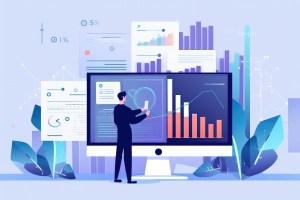How Does Data Analytics Help Drive Sales?



Want to understand the practical value of sales data and insights? Read on to unleash the potential of data analytics to drive more sales!
Imagine a library with no Dewey Decimal System. You’ve got access to tens of thousands of books containing information about every topic imaginable, but no way to find what you want. Say you’re trying to find out something very specific — you’re writing an academic paper about 17th-century pharmacology in France — where would you start? It’s the same with sales data!
You can have more than any of your competitors, but unless you know what’s in it and where it is, it’s useless. As The State of Commerce 2023 highlights, improving data use and management is a priority for both B2B and B2C organisations. Data analytics is to data what the Dewey Decimal System is to a library. It’s a method of organising vast amounts of information, making it usable and useful.
What’s data analytics, how does it benefit you, and how do you use it effectively? And, how can you combine it with your CRM to optimise sales? This blog will help you understand the practical value of data analytics in sales.
How does data analytics help drive sales?
Your business might be collecting data on your customers from touchpoints across their purchase journey. This can include sales data like product preferences and purchase history, demographic and behavioural data, social media engagement, and more. The role of data analytics is to organise this information and give insights that help you shape your engagement with individual customers.
For example, data-driven insights from your CRM allow you to find out which platforms your customers use the most, which products your customers buy the most, or when they’re most likely to buy them.
These data-driven insights help you drive sales by giving you relevant information you can take to engage customers on the platforms you know they use the most: Hi John, I saw this on X and I know you’re passionate about camping, so I thought I’d reach out…
The power of data-driven insights in sales is no secret. Our research in The Data Culture Playbook 2023 shows that 75% of business leaders agree that organisations using analytics to make data-driven decisions achieve significant revenue gains. Rather, the challenge is doing customer data analysis effectively.
Unlocking potential with big data in CRM
You’ll often hear the term big data in CRM. Big data literally means big datasets. But not ‘big’ as in a datasheet with 100 rows. Big as in terabytes. Millions of data points that simply can’t be analysed with traditional methods or tools. Given the amount of customer data that can be harvested in just a single transaction, many businesses face the challenge of making sense of big data. In fact, the majority of IT leaders expect data volumes to increase 22% on average over the next year.
The State of Data and Analytics Report 2023
Want to learn more about data management and decision-making in the age of AI?



Having said that, if you can work with and integrate big data, it’s an opportunity to improve the sales process. The larger your data set, the deeper your insight and the more you can optimise your sales outreach. It can help you identify new markets or space for growth in existing markets, and then how much resource to allocate to that.
For example, traditionally you might have allocated resources based on geography. Big data analysis might show you that a specific segment of customers have similar needs across a few different areas. This allows you to create economies of scale by running your advertising campaigns across different regions. This frees up resources to win new customers in a market that big data analysis highlighted as increasingly responsive to your product messaging. Tools such as Salesforce Data Cloud can work with big data from different sources. This enables your teams to engage with customers at every touchpoint, with relevant, real-time insights.
Harnessing predictive analytics to get ahead
Your business’s sales data can help you predict the future. It’s not exactly a crystal ball, but using statistical algorithms, Machine Learning, and data mining techniques to analyse historical data can help you make informed predictions about future needs and trends. This is called predictive analytics. It identifies patterns, correlations, and relationships within big data.
The insights predictive analytics reveal can help you anticipate customer demands, or determine which new customers will become high-potential leads. For example, within your CRM, data analysis can look at global datasets to determine that in previous years, new customers who engaged with your brand after trade events were more likely to convert. This gives you fresh insight to define your marketing strategy for the year ahead.
Enhancing engagement through customer segmentation
Customer segmentation is how you reach customers at scale. It’s important for effective sales. You can ensure you’re putting the right content in front of the right people, and not putting potential customers off with irrelevant communications.
To effectively achieve this, it’s important to:
- Clearly define business objectives
- Gather relevant data
- Create customer profiles
- Continuously monitor and adjust your categories using data and customer feedback to inform changes
Understanding customer behaviour analytics for personalised sales
Data analytics can further improve sales performance by helping you understand customer behaviour — known as customer behaviour analytics. This shows you how people engage with products and services, and then what kinds of actions those interactions cause. With this CRM data integration and analysis, businesses can decode patterns, preferences, and pain points to create tailored roadmaps for different sales approaches. By understanding behaviour — the emotional drivers and motivations of your customers — you’ve more opportunities to engage customers at every touchpoint with messaging that truly resonates with their needs.
Invest in the future of work with Einstein AI
Boost growth by using AI to create customer success through personalised experiences.


Optimising sales processes with CRM data integration
As you must have understood, CRM data integration can have a significant impact on sales success. Yet, The State of Data and Analytics Report 2023 shows that 94% of business leaders believe they should get more value from their data. So, how do you get your CRM tools to connect with your business data for analysis and insight? It requires data science and software engineering skills, to a greater or lesser degree, depending on the tools you’re using.
Like a science experiment where you start by writing a hypothesis, data analysis requires you to establish your objectives before you begin. Then you need to assess and map out your data sources and Application Programming Interface (APIs), meet any security and compliance requirements and start to knit these together with your CRM tools.
AI-powered CRM tools such as Tableau can do much of the heavy lifting for you. Not only does it enable seamless API integrations, pulling in data from multiple sources to one dashboard, but it also gives you powerful yet simple data analytics that boost productivity and improve decision-making. And, in combination with generative AI like Einstein AI, you can create relevant, personalised outreach messaging at scale.
There’s no question that data analytics helps drive sales. The only question that remains is how effective your organisation is at connecting the dots between your data and delivering deal-closing insights to your sales team.
Build meaningful customer relationships with Data Cloud
Gain a 360-degree view of your customers across all products, services, and interactions with Data Cloud.
























